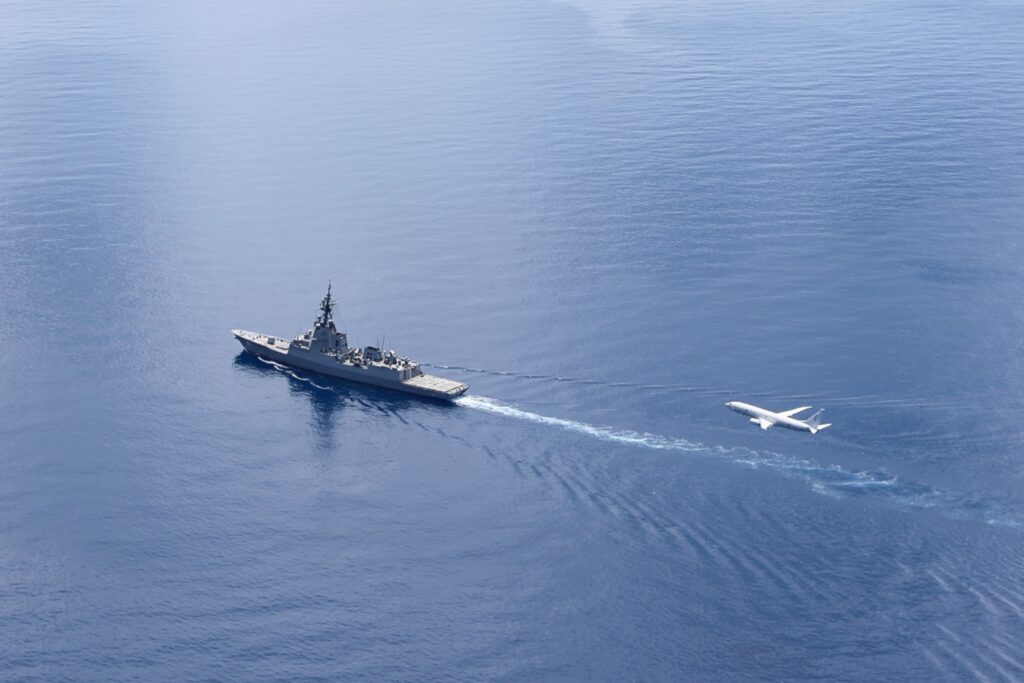
Australia has deployed a warship in the contested South China Sea after China conducted an unprecedented naval circumnavigation of the United States’ ally in the South Pacific Ocean.
Canberra said Australia has a “long history” of operating in the South China Sea, where the Chinese territorial claims overlap with those of several neighbors, including the Philippines.
The Chinese military responded by vowing to “resolutely safeguard” the country’s territorial sovereignty and maritime rights in the South China Sea while upholding peace and stability.
Why It Matters
From mid-February to early March, a Chinese naval task group, consisting of a destroyer, a frigate, and a replenishment ship, sailed around Australia outside its territorial waters, which extend 12 nautical miles [13.8 miles] from the country’s coastline, in a clockwise direction.
Meanwhile, on February 11, an Australian maritime patrol aircraft experienced an “unsafe and unprofessional” interaction with Chinese fighter jets over the South China Sea. Beijing asserted that the intercept was legitimate, accusing Australia of intruding into its airspace.
What To Know
HMAS Sydney, one of three Hobart-class air warfare destroyers in service with the Royal Australian Navy, deployed on April 3 for a three-month mission in the Indo-Pacific region, known as the Regional Presence Deployment 25-2, the Australian Defense Department said.
Following the conclusion of Exercise Bersama Shield 2025, which was held in and around Malaysia from April 7 to 22, the Sydney took part in training events in the South China Sea on April 24 and 25 with the Royal New Zealand Air Force and the U.S. Navy, respectively.

Australian Defense Department
The first training involved a New Zealand P-8A maritime patrol aircraft, while the second one was a joint sail with the U.S. littoral combat ship USS Omaha. The U.S. Navy said the sail supported a free and open Indo-Pacific and enhanced the combined force’s capabilities.
On Tuesday, the Australian warship joined the U.S. and the Philippine militaries for the Multilateral Maritime Cooperative Activity in the West Philippine Sea, referring to the portion of the South China Sea that lies within the Philippines’ exclusive economic zone.
The Armed Forces of the Philippines said this multilateral engagement, which involved air and maritime assets from the three countries, demonstrated “a strong commitment to regional security, interoperability, and cooperation in support of a rules-based international order.”
While the Sydney was transiting the Philippine waters, the Chinese People’s Liberation Army Southern Theater Command conducted what it called “routine patrols” at an undisclosed location in the South China Sea, the Chinese military said the following day.
What People Are Saying
The Australian Defense Department said: “These training activities [in the South China Sea] were conducted in accordance with international law, particularly the United Nations Convention on the Law of the Sea … Deployments to the region are a demonstration of Australia’s resolve to support an open, stable and prosperous Indo-Pacific.”
The Chinese People’s Liberation Army Southern Theater Command said: “Recently, the Philippines has frequently violated rights at sea, provoked and caused incidents, and enlisted foreign countries to organize so-called ‘joint patrols.’ The Chinese People’s Liberation Army Southern Theater Command’s naval and air forces have been on surveillance and alert throughout the whole process, and the situation is under control.”
What Happens Next
It remains to be seen whether the Sydney would transit the Taiwan Strait located to the north of the South China Sea. China has declared that it has “sovereignty, sovereign rights, and jurisdiction” over the waterway that separates China’s mainland and the self-ruled Taiwan.




